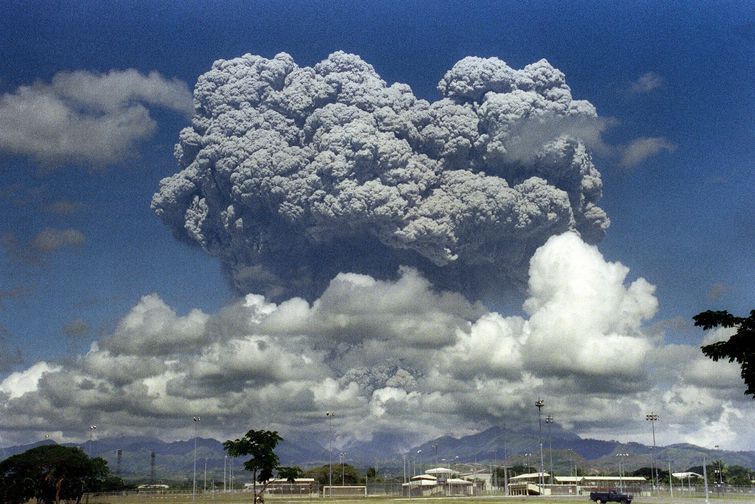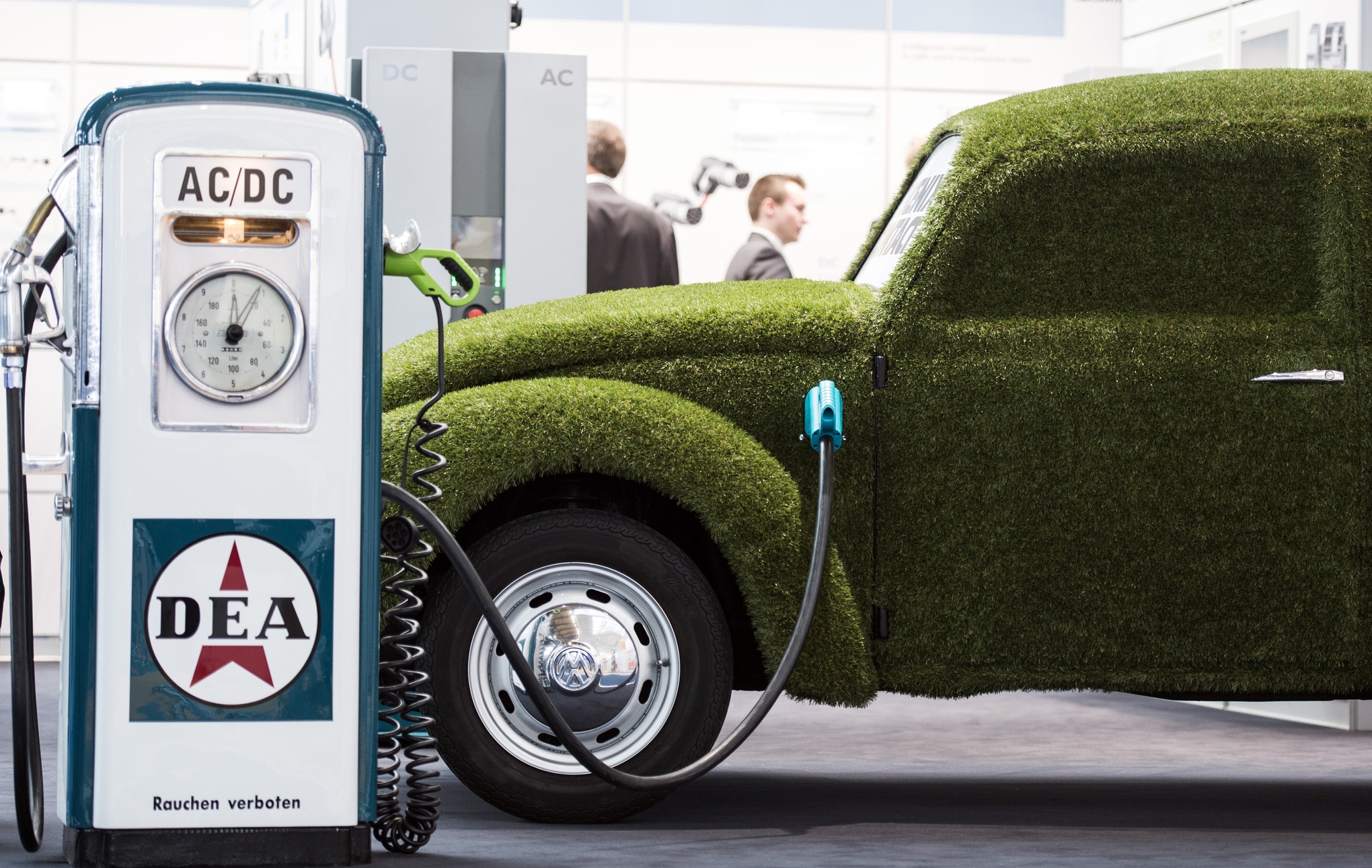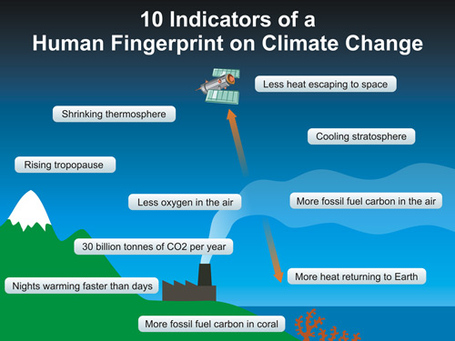Futures Forum: The techno-fix ... Can we engineer our way out of environmental catastrophe? Or ... Can we 'design for the real world'?
Futures Forum: Climate change: the 'Big Fix': geoengineering solutions
Things might go a little wrong, though:

The 2013 movie Snowpiercer took a fanciful look at what might happen if human attempts to engineer the climate were to go awry. A pair of reports from the National Research Council offers a sober, reality-based look.
Geoengineering: The Bad Idea We Need to Stop Climate Change - Bloomberg Business
In 2014, an attempt to counteract global warming through climate engineering catastrophically backfires, resulting in an ice age so severe that nearly all life on Earth is killed. The only survivors are the inhabitants of the Snowpiercer, a massive train powered by aperpetual-motion engine that travels on a globe-spanning track. A class system is installed, with the elites inhabiting the front of the train and the poor inhabiting the tail.
Snowpiercer - Wikipedia, the free encyclopedia
Snowpiercer Official US Release Trailer #1 (2014) - Chris Evans Movie HD - YouTube
The National Research Council has just released a report on the issue:
National-Academies.org | Where the Nation Turns for Independent, Expert Advice
This is the coverage from the New York Times:
Panel Urges Research on Geoengineering as a Tool Against Climate Change

Piles at a CCI Energy Solutions coal handling plant in Shelbiana, Ky. Geoengineering proposals might counteract the effects of climate change that are the result of burning fossils fuels, such as coal. Luke Sharrett/Getty Image
With the planet facing potentially severe impacts from global warming in coming decades, a government-sponsored scientific panel on Tuesday called for more research on geoengineering — technologies to deliberately intervene in nature to counter climate change.
The panel said the research could include small-scale outdoor experiments, which many scientists say are necessary to better understand whether and how geoengineering would work.
Some environmental groups and others say that such projects could have unintended damaging effects, and could set society on an unstoppable path to full-scale deployment of the technologies.
But the National Academy of Sciences panel said that with proper governance, which it said needed to be developed, and other safeguards, such experiments should pose no significant risk.
In two widely anticipated reports, the panel — which was supported by NASA and other federal agencies, including what the reports described as the “U.S. intelligence community” — noted that drastically reducing emissions of carbon dioxide and other greenhouse gases was by far the best way to mitigate the effects of a warming planet.

A device being developed by a company called Global Thermostat, is made to capture carbon dioxide from the air. This may be one solution to counteract climate change.CreditHenry Fountain/The New York Times
But the panel, in making the case for more research into geoengineering, said, “It may be prudent to examine additional options for limiting the risks from climate change.”
“The committee felt that the need for information at this point outweighs the need for shoving this topic under the rug,” Marcia K. McNutt, chairwoman of the panel and the editor in chief of the journal Science, said at a news conference in Washington.
Geoengineering options generally fall into two categories: capturing and storing some of the carbon dioxide that has already been emitted so that the atmosphere traps less heat, or reflecting more sunlight away from the earth so there is less heat to start with. The panel issued separate reports on each.
The panel said that while the first option, called carbon dioxide removal, was relatively low risk, it was expensive, and that even if it was pursued on a planetwide scale, it would take many decades to have a significant impact on the climate. But the group said research was needed to develop efficient and effective methods to both remove the gas and store it so it remains out of the atmosphere indefinitely.
The second option, called solar radiation management, is far more controversial. Most discussions of the concept focus on the idea of dispersing sulfates or other chemicals high in the atmosphere, where they would reflect sunlight, in some ways mimicking the effect of a large volcanic eruption.
The process would be relatively inexpensive and should quickly lower temperatures, but it would have to be repeated indefinitely and would do nothing about another carbon dioxide-related problem: the acidification of oceans.
This approach might also have unintended effects on weather patterns around the world — bringing drought to once-fertile regions, for example. Or it might be used unilaterally as a weapon by governments or even extremely wealthy individuals.
Opponents of geoengineering have long argued that even conducting research on the subject presents a moral hazard that could distract society from the necessary task of reducing the emissions that are causing warming in the first place.
“A geoengineering ‘technofix’ would take us in the wrong direction,” Lisa Archer, food and technology program director of the environmental group Friends of the Earth, said in a statement. “Real climate justice requires dealing with root causes of climate change, not launching risky, unproven and unjust schemes.”
But the panel said that society had “reached a point where the severity of the potential risks from climate change appears to outweigh the potential risks from the moral hazard” of conducting research.
Ken Caldeira, a geoengineering researcher at the Carnegie Institution for Science and a member of the committee, said that while the panel felt that it was premature to deploy any sunlight-reflecting technologies today, “it’s worth knowing more about them,” including any problems that might make them unworkable.
“If there’s a real showstopper, we should know about it now,” Dr. Caldeira said, rather than discovering it later when society might be facing a climate emergency and desperate for a solution.
Dr. Caldeira is part of a small community of scientists who have researched solar radiation management concepts. Almost all of the research has been done on computers, simulating the effects of the technique on the climate. One attempt in Britain in 2011 to conduct an outdoor test of some of the engineering concepts provoked a public outcry. The experiment was eventually canceled.
David Keith, a researcher at Harvard University who reviewed the reports before they were released, said in an interview, “I think it’s terrific that they made a stronger call than I expected for research, including field research.” Along with other researchers, Dr. Keith has proposed a field experiment to test the effect of sulfate chemicals on atmospheric ozone.
Unlike some European countries, the United States has never had a separate geoengineering research program. Dr. Caldeira said establishing a separate program was unlikely, especially given the dysfunction in Congress. But he said that because many geoengineering research proposals might also help in general understanding of the climate, agencies that fund climate research might start to look favorably upon them.
Dr. Keith agreed, adding that he hoped the new reports would “break the logjam” and “give program managers the confidence they need to begin funding.”
At the news conference, Waleed Abdalati, a member of the panel and a professor at the University of Colorado, said that geoengineering research would have to be subject to governance that took into account not just the science, “but the human ramifications, as well.”
Dr. Abdalati said that, in general, the governance needed to precede the research. “A framework that addresses what kinds of activities would require governance is a necessary first step,” he said.
Raymond Pierrehumbert, a geophysicist at the University of Chicago and a member of the panel, said in an interview that while he thought that a research program that allowed outdoor experiments was potentially dangerous, “the report allows for enough flexibility in the process to follow that it could be decided that we shouldn’t have a program that goes beyond modeling.”
Above all, he said, “it’s really necessary to have some kind of discussion among broader stakeholders, including the public, to set guidelines for an allowable zone for experimentation.”
Panel Urges Research on Geoengineering as a Tool Against Climate Change - NYTimes.com
This is a very useful overview of the options:
Geoengineering is an insane way to deal with climate change. Let's consider it anyway.

When Pinatubo erupted in 1991, it released enough sulfates to cool the Earth 0.3°C for three years. Should we try something similar?
Geoengineering — the idea of deliberately fiddling with the Earth's climate to reduce global warming — has long been seen as an insane, preposterous, mad-scientist notion. Surely we'd have to be truly desperate before we ever tried something like blotting out sunlight to cool the planet.
...right?
Right. But that's why it's so striking that many scientists now think we should at least consider some of these crazy ideas.
This week, an expert panel convened by the National Academy of Sciences released two big reports on "climate intervention" schemes. Thefirst report was harmless enough, looking at ways to suck out some of the heat-trapping carbon-dioxide we've put into the atmosphere. Those technologies are quite promising; they're just expensive and likely limited. Definitely worth researching.
The second report, however, dealt with far more controversial ideas like putting reflective particles in the atmosphere to block some sunlight and cool the planet. This could be done cheaply, but it's extremely risky, and could wreak havoc on global rainfall patterns. The report warned we should absolutely not try this anytime soon. It's still too poorly understood. But it is worth studying further — just in case.
Neither of these ideas can ever be a substitute for the traditional approach to tackling climate change: burning fewer fossil fuels and emitting fewer greenhouse gases. The trouble is that we've been slow to do that, and we've locked in a fair bit of global warming already. So, the report notes, we may need some additional tools to deal with the mess we've made.
"That scientists are even considering technological interventions should be a wake-up call that we need to do more now to reduce emissions, which is the most effective, least risky way to combat climate change," said Marcia McNutt, the editor-in-chief of Science who led the committee, in a statement.
The basic case for considering geoengineering
/cdn0.vox-cdn.com/uploads/chorus_asset/file/3402528/84004858.0.0.0.jpg)
(David McNew/Getty Images)
The science of global warming is straightforward enough. When we burn fossil fuels, we add carbon-dioxide to the atmosphere. That extra CO2 traps additional heat and warms the planet further. So the solution seems obvious: If we want to stop warming the planet, we should burn less coal, oil, and gas.
The catch is that we've been slow to do this. Emissions keep rising year after year. We've now warmed the planet about 1.4°F (0.8°C) since the 19th century and have locked in significant changes to the Earth's climate, like melting ice caps and rising sea levels.
We've also reached the point where cutting emissions alone won't avert all negative impacts. Scientists have found that ocean levels will keep rising for the next 100 years even if we zero out all emissions tomorrow — thanks to the extra heat we've loaded into the system. Our only choice, at this point, is between a medium rise and a really huge rise
Sea-level rise under low (blue) and high (red) emissions scenarios
/cdn0.vox-cdn.com/uploads/chorus_asset/file/3402550/global_mean_sea_level_rise.0.png)
(Intergovernmental Panel on Climate Change)
That's why some scientists, like Harvard's David Keith, have argued that we should at least research additional ideas like reflecting sunlight to cool the Earth.
"These technologies appear to provide a pathway by which we could substantially reduce climate risks over the next half-century," Keith told me in a previous interview. "That means reducing the risks of sea-level rise, reducing the risks of stress for the crops of people in the poorest and hottest parts of the world."
"This would be complementary to emissions reductions," Keith clarified. "Nothing changes the fact that in the long run, the only way to manage carbon risk is to stop emitting carbon-dioxide. But, similarly ... nothing plausible we do to reduce emissions in the next, say, quarter-century is going to materially reduce the risks for real people, especially some of the poorest and most vulnerable on our planet from climate change."
Why it's so risky to cool the Earth by reflecting sunlight
So let's look at the mad-scientist scheme — reflecting sunlight to counteract the effects of carbon-dioxide and cool the Earth. The National Academy of Sciences report calls this "albedo modification," and notes there are a few cheap and simple ways we could do this.
/cdn0.vox-cdn.com/uploads/chorus_asset/file/3402576/Screen_Shot_2015-02-12_at_7.14.15_AM.0.png)
We could spray sulfate particles into the stratosphere to reflect more incoming sunlight back into space. This is basically what volcanic eruptions do: when Mount Pinatubo erupted in 1991, it temporarily lowered the Earth's temperature by nearly 0.3°C for three years. Or we could try to increase the reflectivity of clouds by, say, spraying seawater into the atmosphere.
The catch is that these methods could have unforeseen and horrible side effects. It's likely that putting lots of reflective particles into the atmosphere would muck up global rainfall and monsoon patterns. Adding sulfate to the stratosphere could deplete the ozone layer that protects us from the sun's harmful UV rays. Some past volcanic eruptions — like Tambora in 1815 — have led to widespread crop failures.
The report notes that scientists still don't have a good handle on all the risks involved, and sayswe shouldn't even term this "engineering," since that implies a level of control we don't have.Little wonder that Raymond Pierrehumbert, a University of Chicago scientist who was on the committee, says these solar-reflection proposals are "wildly, utterly, howlingly barking mad."
Another huge problem: Say we tried to reflect some sunlight but continued burning fossil fuels and kept loading the atmosphere with carbon-dioxide. All that extra CO2 would continue to trap heat on the Earth — which means we'd have to keep spraying reflective particles into the atmosphere pretty much forever (the particles don't stay up there long).
If, for whatever reason, we ever stopped spraying, the Earth would heat up very suddenly — 1.5°C or more in a single decade. It'd be a catastrophe:
/cdn0.vox-cdn.com/uploads/chorus_asset/file/3402600/Screen_Shot_2015-02-12_at_7.22.05_AM.0.png)
Results of 11 climate models showing global average temperatures with albedo modification. It then stops after year 50 — and temperatures rise by 1.5°C in one decade. (Jones et. al 2013)
Better hope no one slips and we can keep this going for thousands and thousands of years without interruption.
Geoengineering also doesn't address some of the most dire effect of climate change. For example, as we pump out more carbon-dioxide, some of it dissolves in the oceans and makes the seas more acidic. That chews away at coral reefs and poses a major risk to marine life. Reflecting a bit more sunlight does nothing for ocean acidification.
And perhaps the biggest pitfalls are geopolitical. The technology to reflect sunlight is so cheap that individual countries or even a wealthy billionaire could try it. What then? Who decides how much sunlight to reflect? "We lack even the basics of how to create a norm of behaviors around this technology," Keith told me back in 2013, "let alone a treaty to make decisions about how to set the thermostat."
Even so, we should study solar geoengineering further

Would we need to consider geoengineering in an emergency situation? (USDA)
The committee warns that no one should try any large-scale sunlight-reflecting schemes right now, period. The risks are too poorly understood. The dangers are too great. Keith agrees, calling for a global moratorium on deployment until we understand the technology better.
But, significantly, the report does urge scientists to start studying these methods further, both through better computer modeling and perhaps through cautious, small-scale experiments.
Why? Partly because global warming may someday become so severe that we have to consider some albedo modification — at least as part of a broader strategy.
Let's say we're slow to cut emissions in the decades ahead, and global warming leads to massive crop failures throughout the tropics. The world might face a tough decision of whether to deploy solar geoengineering in addition to cutting emissions and potentially pulling more carbon out of the atmosphere in order to blunt the impacts.*
The other rationale for research? At some point, someone might decide to deploy solar geoengineering unilaterally. What if China decides to use it in order to alter rainfall patterns? It might be a good idea for scientists to have a better understanding of what will ensue. The committee notes that the world should also start thinking seriously about global governance issues.
For years, scientists have mainly studied geoengineering through computer modeling. The US doesn't have any sort of formal process for permitting small-scale experiments. It's a touchy subject. The United Kingdom put forward a $150 million research program in 2009 — and, as Eli Kintisch reports, most of the proposed field experiments (like releasing extra water vapor into the air) have been bogged in controversy.
The National Research Council is now recommending that the government start funding at least some research into the matter. (Keith, for instance, has proposed releasing a pound or so of sulfuric acid into the atmosphere to see the effects of ozone.) It's unclear whether that recommendation will translate into federal funding. But the subject is slowly becoming less taboo.
What about sucking carbon dioxide out of the atmosphere?

A grass covered mock VW electronic beetle car is pictured at the Hannover Messe industrial trade fair in Hanover, central Germany on April 7, 2014. (JOHANNES EISELE/AFP/Getty Images)
Crazy schemes to reflect sunlight get all the attention, but the committee also looked at another option for tackling global warming — pulling carbon dioxide out of the atmosphere.
We could do this by planting more trees, although there’s only so much land to go around (especially as demand for cropland grows). We could harvest plants that scoop carbon dioxide out of the atmosphere, burn them for electricity, and then capture the resulting carbon-dioxide at the smokestack and bury it underground. This would, in theory, be carbon negative:
/cdn0.vox-cdn.com/uploads/chorus_asset/file/3402722/Screen_Shot_2015-02-12_at_7.47.56_AM.0.png)
Climate Intervention: Carbon Dioxide Removal and Reliable Sequestration (National Research Council)
Or we could invent some sort of machine that scoops carbon-dioxide directly out of the air and buries it underground.
All of these options are pretty low-risk, so long as we can make sure the stored carbon stays underground. (The one exception is an idea for trying to fertilize the ocean with iron to promote the growth of plankton that absorb carbon-dioxide — that might have adverse side effects.)
The main drawbacks are that these technologies are immature, expensive and would act slowly. It's easy to burn a chunk of coal and release carbon-dioxide into the air, where it mixes in the atmosphere thoroughly. It's much, much harder to pluck that carbon dioxide back out. So it's unlikely we'll be able to devise a carbon-sucking machine that offsets all of our emissions. Just some.
Still, the reports recommend further research in this area, too. Indeed, these technologies may even become essential down the road. Most climate modeling suggests that we probably can't avoid drastic global warming — 3.6°F (2°C) or more — if we can't find a way to pull at least some carbon out of the atmosphere by the end of the century.
------
* Clarification: I'd originally written that we may need to consider doing solar geoengineering "temporarily" while we worked to cut emissions and pull CO2 out of the atmosphere. This is a bit misleading. If we start reflecting sunlight but the amount of carbon-dioxide in the atmosphere stayed the same (or kept rising), we'd essentially have to continue solar geoengineering forever to keep the planet cooler. Geoengineering could only be temporary if we found some way to pull significant carbon out of the atmosphere — an uncertain prospect.
Further reading
-- Here's an in-depth interview I did with David Keith discussing the pros and cons of geoengineering.
-- Eli Kintisch has an excellent piece surveying the landscape of research funding for geoengineering. One tidbit: "The biggest funder of geoengineering research has been a nonprofit fund supported by billionaire Bill Gates, which has disbursed some $8.5 million for research and meetings since 2007."
-- Raymond Pierrehumbert, one of the members of the committee, explainswhy he still thinks solar-reflection schemes are "wildly, utterly, howlingly barking mad."
- FILED UNDER:
- Energy,
- Climate Change,
- Health and Science
Geoengineering is an insane way to deal with climate change. Let's consider it anyway. - Vox
.
.
.


No comments:
Post a Comment